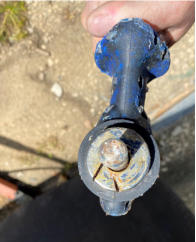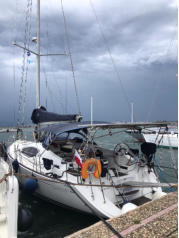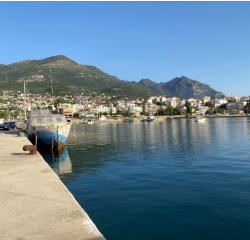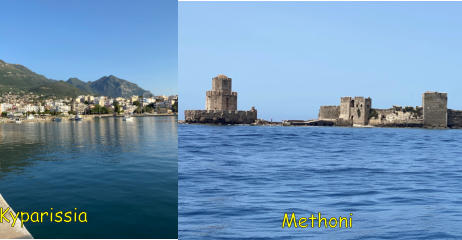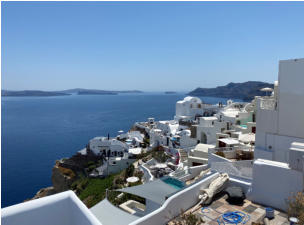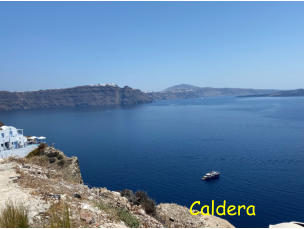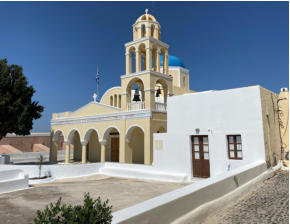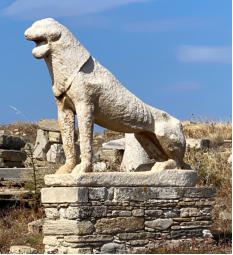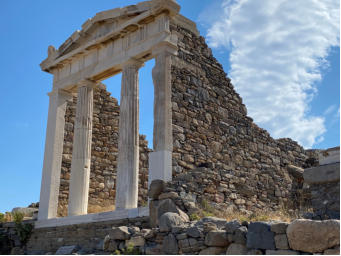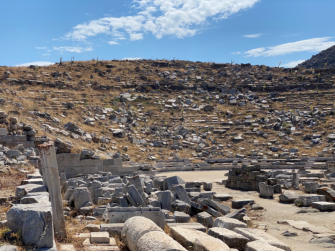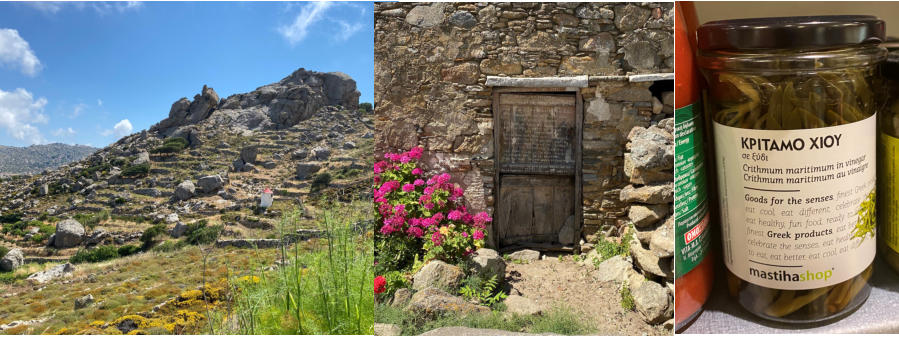

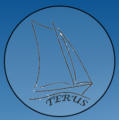









Our Journey: 2021
Preveza to Santorini and Tinos: (May to June 2021)
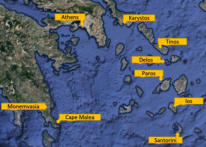
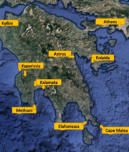
The start of 2021 was again a journey as many roadblocks had to be overcome before we could travel. The spread of Covid could not be stopped so authorities tried to limit the spread of the
travel. The spread of Covid could not be stopped so authorities tried to limit the spread of the virus by limiting everyone’s ability to travel. Getting on a plane to Greece was a
virus by limiting everyone’s ability to travel. Getting on a plane to Greece was a complexundertaking as you needed to complete various forms ( PLF, negative Covid test result
complexundertaking as you needed to complete various forms ( PLF, negative Covid test result less than 72 hours old etc…) as well as a mandatory quarantine of 1week upon arrival. We were
less than 72 hours old etc…) as well as a mandatory quarantine of 1week upon arrival. We were well prepared and the flight on the 15 of March went smoothly. After our mandatory 7 days
well prepared and the flight on the 15 of March went smoothly. After our mandatory 7 days quarantine we could finally board Terus. We found the boat in good condition and no surprises on
quarantine we could finally board Terus. We found the boat in good condition and no surprises on board.Our first priority was to reinstall the gearbox that was repaired by the technician during
board.Our first priority was to reinstall the gearbox that was repaired by the technician during the winter. We also asked the technician to check the heat exchanger to make sure it was clean.
the winter. We also asked the technician to check the heat exchanger to make sure it was clean. New batteries were needed as the existing ones were 7 years old and did not keep their full
New batteries were needed as the existing ones were 7 years old and did not keep their full charge when not used. But the big job was the replacement of all the water pipes (cold and hot
charge when not used. But the big job was the replacement of all the water pipes (cold and hot water). The job had been delayed for 2 years but now the pipes were giving the water a very bad
water). The job had been delayed for 2 years but now the pipes were giving the water a very bad smell and replacement was a must. It took us 5 days of work to complete the job as some pipes
smell and replacement was a must. It took us 5 days of work to complete the job as some pipes were difficult to reach. By the end we had replaced 70 meters of pipes. Once completed we
were difficult to reach. By the end we had replaced 70 meters of pipes. Once completed we disinfected the taps and since then the water that no longer a disgusting smell. We also had
disinfected the taps and since then the water that no longer a disgusting smell. We also had noticed a leak of oil at the level of the bowthruster and after having removed the propellers we
noticed a leak of oil at the level of the bowthruster and after having removed the propellers we realized that during some maintenance in Ragusa the base of the bowthruster had been damaged
realized that during some maintenance in Ragusa the base of the bowthruster had been damaged by the angle grinder they used. Of course they had covered it up and now we needed to replace
by the angle grinder they used. Of course they had covered it up and now we needed to replace the base of the bowthruster.
the base of the bowthruster.
 In order to try to limit the spread of the Covid virus in the islands, all boats were prevented
In order to try to limit the spread of the Covid virus in the islands, all boats were prevented from sailing. It was only on the 15th of May that the restrictions were lifted. On that day,
from sailing. It was only on the 15th of May that the restrictions were lifted. On that day, Terus was the first boat to be put in the water and stayed a few days in Preveza to supply the
Terus was the first boat to be put in the water and stayed a few days in Preveza to supply the boat, before setting sail towards the south. We wanted to go ASAP towards the Cyclades
boat, before setting sail towards the south. We wanted to go ASAP towards the Cyclades islands before the Meltemi season (a strong kind of Mistral that blows frequently in July and
islands before the Meltemi season (a strong kind of Mistral that blows frequently in July and August). Due to the fact that the Corinthe canal was closed we had to go around the
August). Due to the fact that the Corinthe canal was closed we had to go around the Peloponnese, but we only stopped briefly in the ports of Kyllini and Kyparissia. A UK friend of
Peloponnese, but we only stopped briefly in the ports of Kyllini and Kyparissia. A UK friend of ours who is a big supporter of Brexit had told me that those 2 harbours have nothing to offer.
ours who is a big supporter of Brexit had told me that those 2 harbours have nothing to offer. He described them as two white elephants paid for by the EU and no longer maintained by
He described them as two white elephants paid for by the EU and no longer maintained by  Greece. I would say that his definition is quite correct. After having spent one night in those
Greece. I would say that his definition is quite correct. After having spent one night in those harbours we could continue towards the east. We enjoyed a nice anchorage in Methoni and
harbours we could continue towards the east. We enjoyed a nice anchorage in Methoni and Elafonisos before passing around Cape Malea, which can be dangerous. Luckily, we had a pleasant
Elafonisos before passing around Cape Malea, which can be dangerous. Luckily, we had a pleasant sail and later reached the port of Monemvasia that we know very well. After a few days, we
sail and later reached the port of Monemvasia that we know very well. After a few days, we sailed at 4am. to the Cycladic island of Paros where a
sailed at 4am. to the Cycladic island of Paros where a 
 friend was waiting for us. Paros is an island with plenty of beaches and nice anchorages. We
friend was waiting for us. Paros is an island with plenty of beaches and nice anchorages. We rented a motorbike and visited several of them, especially the ones on the east side of the
rented a motorbike and visited several of them, especially the ones on the east side of the island. From Paros we decided to move towards Santorini. In 1620 BC there was a huge volcanic
island. From Paros we decided to move towards Santorini. In 1620 BC there was a huge volcanic eruption and the whole mountain blew up. All we can see today is a ring of a few islands that
eruption and the whole mountain blew up. All we can see today is a ring of a few islands that were part of the original volcano. Luckily the eruption was preceded by a lot of warning signs and
were part of the original volcano. Luckily the eruption was preceded by a lot of warning signs and people left the island in good time. We could attach Terus and our friend's boat to a buoy in the
people left the island in good time. We could attach Terus and our friend's boat to a buoy in the old crater. Today, when you are in the middle of the caldera where the volcano once stood, it is
old crater. Today, when you are in the middle of the caldera where the volcano once stood, it is difficult to imagine that such a huge mountain could explode and fly up into the atmosphere.
difficult to imagine that such a huge mountain could explode and fly up into the atmosphere. Today, Santorini eruption is still one of the most violent eruptions known to mankind. Everything
Today, Santorini eruption is still one of the most violent eruptions known to mankind. Everything is now quiet and seeing the caldera with the white houses on top is a unique view and explains
is now quiet and seeing the caldera with the white houses on top is a unique view and explains why this place is one of the most popular spots in Greece.
why this place is one of the most popular spots in Greece.
 We really loved this place and the limited number of tourists on the island was one thing we
We really loved this place and the limited number of tourists on the island was one thing we really appreciated. After Santorini we had to start moving northwards as our children were
really appreciated. After Santorini we had to start moving northwards as our children were going to join us at the end of June. We were still 250 km away from the meeting point. Not a big
going to join us at the end of June. We were still 250 km away from the meeting point. Not a big distance if the winds are favorable. And luck was on our side. The Meltemi was not yet active so
distance if the winds are favorable. And luck was on our side. The Meltemi was not yet active so we could even stop at some islands for some sightseeing. We stopped at Ios island for the night.
we could even stop at some islands for some sightseeing. We stopped at Ios island for the night. It is said that Homer
It is said that Homer 
 was born on this island and he is also buried here. We did not visit his grave but continued
was born on this island and he is also buried here. We did not visit his grave but continued towards Koufonissi, then Delos. Delos island is located not far away from Mykonos but in the 6th
towards Koufonissi, then Delos. Delos island is located not far away from Mykonos but in the 6th century BC it was a very important site. The island is only 3.5 sq km, but it had enough water to
century BC it was a very important site. The island is only 3.5 sq km, but it had enough water to sustain the lives of 5,000 people. It was considered the birthplace of the god Apollo. There used
sustain the lives of 5,000 people. It was considered the birthplace of the god Apollo. There used to a big temple dedicated to Apollo there, but today only ruins remain. The island is classified by
to a big temple dedicated to Apollo there, but today only ruins remain. The island is classified by Unesco as a world heritage site. Delos was at a certain time also a place where slaves were
Unesco as a world heritage site. Delos was at a certain time also a place where slaves were traded. In around the 1st century AD, the island lost its glory and slowly became covered in
traded. In around the 1st century AD, the island lost its glory and slowly became covered in vegetation. The site was completely buried in vegetation in 1864 when the archeologist
vegetation. The site was completely buried in vegetation in 1864 when the archeologist redicovered it. The excavations revealed the importance of the place and one remarquable
redicovered it. The excavations revealed the importance of the place and one remarquable discovery was the alley of
discovery was the alley of
 lions. Originally, 9 lions were lined up on either side of the way to the temple of Apollo or
lions. Originally, 9 lions were lined up on either side of the way to the temple of Apollo or Artemis. Today, only 5 lions remain. Two more have been moved, one to the museum of the
Artemis. Today, only 5 lions remain. Two more have been moved, one to the museum of the island, and the other to Venice in 1716. The remaining 2 are missing and nobody knows their fate.
island, and the other to Venice in 1716. The remaining 2 are missing and nobody knows their fate. On the archeological site you also discover some remains of villas with some beautiful floor
On the archeological site you also discover some remains of villas with some beautiful floor ceramics. They are protected by the guards because some tourists have no scruples and do not
ceramics. They are protected by the guards because some tourists have no scruples and do not hesitate to take away a souvenir with them, which is of course, strictly prohibited. After Delos,
hesitate to take away a souvenir with them, which is of course, strictly prohibited. After Delos, we moved to the island of Tinos. This island is very interesting as it has some unique features. It
we moved to the island of Tinos. This island is very interesting as it has some unique features. It is not on the classical tourist circuit; mostly only Greek people visit it. On the island, there is
is not on the classical tourist circuit; mostly only Greek people visit it. On the island, there is the church of Panagia Evangelistra which is a very important pilgrimage destination. So I
the church of Panagia Evangelistra which is a very important pilgrimage destination. So I 
 would advise you to visit the place when there are no religious festivities. In 1822, a nurse had a
would advise you to visit the place when there are no religious festivities. In 1822, a nurse had a vision and discovered an iconic painting of the Virgin with the child. The painting is said to have
vision and discovered an iconic painting of the Virgin with the child. The painting is said to have been painted by the apostle St Lucas himself. Soon it was discovered that the icon could heal
been painted by the apostle St Lucas himself. Soon it was discovered that the icon could heal people and people started to visit the painting hoping to be cured. In 1915, when King Constantin
people and people started to visit the painting hoping to be cured. In 1915, when King Constantin of Greece was severely ill, the government sent a boat to bring back the painting to place it in
of Greece was severely ill, the government sent a boat to bring back the painting to place it in the king’s bedroom. His condition improved rapidly once he had kissed the painting, and Queen
the king’s bedroom. His condition improved rapidly once he had kissed the painting, and Queen Sofia gave a sapphire that was added to the icon to thank the Virgin. Today, from the harbour
Sofia gave a sapphire that was added to the icon to thank the Virgin. Today, from the harbour to the basilica you see many women crawling on their knees up the hill to the church. The
to the basilica you see many women crawling on their knees up the hill to the church. The distance is about 200 meters and a carpet is placed on the road for them to crawl on. Many
distance is about 200 meters and a carpet is placed on the road for them to crawl on. Many women who cannot conceive hope that this will help them. Inside the cathedral you will see a lot
women who cannot conceive hope that this will help them. Inside the cathedral you will see a lot of silver gifts to the Virgin. But Tinos has more to offer. A lot of villages on the hills called
of silver gifts to the Virgin. But Tinos has more to offer. A lot of villages on the hills called Choras are worth the visit. To visit them you can easily rent a motorbike and from there you
Choras are worth the visit. To visit them you can easily rent a motorbike and from there you have a beautiful view of the sea. In the middle of the island there is a landscape made of large
have a beautiful view of the sea. In the middle of the island there is a landscape made of large volcanic blocks. The village of Volax, located next to it, is beautiful and quiet. One thing that
volcanic blocks. The village of Volax, located next to it, is beautiful and quiet. One thing that surprised us was the texts written on the doors of some houses. In the end, it turned out that a
surprised us was the texts written on the doors of some houses. In the end, it turned out that a local artist offered to ornate the
local artist offered to ornate the
 wooden walls of the houses if the owners agreed. The texts are nothing special, but certainly a
wooden walls of the houses if the owners agreed. The texts are nothing special, but certainly a curiosity of the village. When leaving the village we found a little stall selling some regional
curiosity of the village. When leaving the village we found a little stall selling some regional products. We discovered a special herb called Kritamos. The plant grows not only on sandy
products. We discovered a special herb called Kritamos. The plant grows not only on sandy beaches in Tinos, but also in many other places in Greece and Europe. For our lunch, we stoppedin
beaches in Tinos, but also in many other places in Greece and Europe. For our lunch, we stoppedin a taverna and they had added this plant to the salad. It has a unique sweet taste. If you can buy
a taverna and they had added this plant to the salad. It has a unique sweet taste. If you can buy this herb that is preserved in a vinegar solution you have to taste it as I am sure you will like it.
this herb that is preserved in a vinegar solution you have to taste it as I am sure you will like it. As we continued our visit to the island we came upon some houses decorated with little
As we continued our visit to the island we came upon some houses decorated with little triangular motifs. In the past, during the Venitian period, it was good to show your financial
triangular motifs. In the past, during the Venitian period, it was good to show your financial  health by having a dovecote with a lot of doves. If a big event had to be celebrated, serving
health by having a dovecote with a lot of doves. If a big event had to be celebrated, serving pigeon was highly
pigeon was highly
 appreciated. Tinos also has a marble museum that explains in detail not only how important the
appreciated. Tinos also has a marble museum that explains in detail not only how important the marble industry is for Greece, but also how the skilled craftsman carve the marble in the past.
marble industry is for Greece, but also how the skilled craftsman carve the marble in the past. Today, this hard job is now totaly mechanical and requires many fewer workers then in the past.
Today, this hard job is now totaly mechanical and requires many fewer workers then in the past. After Tinos, we stopped briefly in the harbour of Andros island before going on to the west site
After Tinos, we stopped briefly in the harbour of Andros island before going on to the west site of Eubee island (also caled Evia) an island of 160 km that is located next to the Greek mainland
of Eubee island (also caled Evia) an island of 160 km that is located next to the Greek mainland  and looks like a sea horse on a map.
and looks like a sea horse on a map.
 travel. The spread of Covid could not be stopped so authorities tried to limit the spread of the
travel. The spread of Covid could not be stopped so authorities tried to limit the spread of the virus by limiting everyone’s ability to travel. Getting on a plane to Greece was a
virus by limiting everyone’s ability to travel. Getting on a plane to Greece was a complexundertaking as you needed to complete various forms ( PLF, negative Covid test result
complexundertaking as you needed to complete various forms ( PLF, negative Covid test result less than 72 hours old etc…) as well as a mandatory quarantine of 1week upon arrival. We were
less than 72 hours old etc…) as well as a mandatory quarantine of 1week upon arrival. We were well prepared and the flight on the 15 of March went smoothly. After our mandatory 7 days
well prepared and the flight on the 15 of March went smoothly. After our mandatory 7 days quarantine we could finally board Terus. We found the boat in good condition and no surprises on
quarantine we could finally board Terus. We found the boat in good condition and no surprises on board.Our first priority was to reinstall the gearbox that was repaired by the technician during
board.Our first priority was to reinstall the gearbox that was repaired by the technician during the winter. We also asked the technician to check the heat exchanger to make sure it was clean.
the winter. We also asked the technician to check the heat exchanger to make sure it was clean. New batteries were needed as the existing ones were 7 years old and did not keep their full
New batteries were needed as the existing ones were 7 years old and did not keep their full charge when not used. But the big job was the replacement of all the water pipes (cold and hot
charge when not used. But the big job was the replacement of all the water pipes (cold and hot water). The job had been delayed for 2 years but now the pipes were giving the water a very bad
water). The job had been delayed for 2 years but now the pipes were giving the water a very bad smell and replacement was a must. It took us 5 days of work to complete the job as some pipes
smell and replacement was a must. It took us 5 days of work to complete the job as some pipes were difficult to reach. By the end we had replaced 70 meters of pipes. Once completed we
were difficult to reach. By the end we had replaced 70 meters of pipes. Once completed we disinfected the taps and since then the water that no longer a disgusting smell. We also had
disinfected the taps and since then the water that no longer a disgusting smell. We also had noticed a leak of oil at the level of the bowthruster and after having removed the propellers we
noticed a leak of oil at the level of the bowthruster and after having removed the propellers we realized that during some maintenance in Ragusa the base of the bowthruster had been damaged
realized that during some maintenance in Ragusa the base of the bowthruster had been damaged by the angle grinder they used. Of course they had covered it up and now we needed to replace
by the angle grinder they used. Of course they had covered it up and now we needed to replace the base of the bowthruster.
the base of the bowthruster.
 In order to try to limit the spread of the Covid virus in the islands, all boats were prevented
In order to try to limit the spread of the Covid virus in the islands, all boats were prevented from sailing. It was only on the 15th of May that the restrictions were lifted. On that day,
from sailing. It was only on the 15th of May that the restrictions were lifted. On that day, Terus was the first boat to be put in the water and stayed a few days in Preveza to supply the
Terus was the first boat to be put in the water and stayed a few days in Preveza to supply the boat, before setting sail towards the south. We wanted to go ASAP towards the Cyclades
boat, before setting sail towards the south. We wanted to go ASAP towards the Cyclades islands before the Meltemi season (a strong kind of Mistral that blows frequently in July and
islands before the Meltemi season (a strong kind of Mistral that blows frequently in July and August). Due to the fact that the Corinthe canal was closed we had to go around the
August). Due to the fact that the Corinthe canal was closed we had to go around the Peloponnese, but we only stopped briefly in the ports of Kyllini and Kyparissia. A UK friend of
Peloponnese, but we only stopped briefly in the ports of Kyllini and Kyparissia. A UK friend of ours who is a big supporter of Brexit had told me that those 2 harbours have nothing to offer.
ours who is a big supporter of Brexit had told me that those 2 harbours have nothing to offer. He described them as two white elephants paid for by the EU and no longer maintained by
He described them as two white elephants paid for by the EU and no longer maintained by  Greece. I would say that his definition is quite correct. After having spent one night in those
Greece. I would say that his definition is quite correct. After having spent one night in those harbours we could continue towards the east. We enjoyed a nice anchorage in Methoni and
harbours we could continue towards the east. We enjoyed a nice anchorage in Methoni and Elafonisos before passing around Cape Malea, which can be dangerous. Luckily, we had a pleasant
Elafonisos before passing around Cape Malea, which can be dangerous. Luckily, we had a pleasant sail and later reached the port of Monemvasia that we know very well. After a few days, we
sail and later reached the port of Monemvasia that we know very well. After a few days, we sailed at 4am. to the Cycladic island of Paros where a
sailed at 4am. to the Cycladic island of Paros where a 
 friend was waiting for us. Paros is an island with plenty of beaches and nice anchorages. We
friend was waiting for us. Paros is an island with plenty of beaches and nice anchorages. We rented a motorbike and visited several of them, especially the ones on the east side of the
rented a motorbike and visited several of them, especially the ones on the east side of the island. From Paros we decided to move towards Santorini. In 1620 BC there was a huge volcanic
island. From Paros we decided to move towards Santorini. In 1620 BC there was a huge volcanic eruption and the whole mountain blew up. All we can see today is a ring of a few islands that
eruption and the whole mountain blew up. All we can see today is a ring of a few islands that were part of the original volcano. Luckily the eruption was preceded by a lot of warning signs and
were part of the original volcano. Luckily the eruption was preceded by a lot of warning signs and people left the island in good time. We could attach Terus and our friend's boat to a buoy in the
people left the island in good time. We could attach Terus and our friend's boat to a buoy in the old crater. Today, when you are in the middle of the caldera where the volcano once stood, it is
old crater. Today, when you are in the middle of the caldera where the volcano once stood, it is difficult to imagine that such a huge mountain could explode and fly up into the atmosphere.
difficult to imagine that such a huge mountain could explode and fly up into the atmosphere. Today, Santorini eruption is still one of the most violent eruptions known to mankind. Everything
Today, Santorini eruption is still one of the most violent eruptions known to mankind. Everything is now quiet and seeing the caldera with the white houses on top is a unique view and explains
is now quiet and seeing the caldera with the white houses on top is a unique view and explains why this place is one of the most popular spots in Greece.
why this place is one of the most popular spots in Greece.
 We really loved this place and the limited number of tourists on the island was one thing we
We really loved this place and the limited number of tourists on the island was one thing we really appreciated. After Santorini we had to start moving northwards as our children were
really appreciated. After Santorini we had to start moving northwards as our children were going to join us at the end of June. We were still 250 km away from the meeting point. Not a big
going to join us at the end of June. We were still 250 km away from the meeting point. Not a big distance if the winds are favorable. And luck was on our side. The Meltemi was not yet active so
distance if the winds are favorable. And luck was on our side. The Meltemi was not yet active so we could even stop at some islands for some sightseeing. We stopped at Ios island for the night.
we could even stop at some islands for some sightseeing. We stopped at Ios island for the night. It is said that Homer
It is said that Homer 
 was born on this island and he is also buried here. We did not visit his grave but continued
was born on this island and he is also buried here. We did not visit his grave but continued towards Koufonissi, then Delos. Delos island is located not far away from Mykonos but in the 6th
towards Koufonissi, then Delos. Delos island is located not far away from Mykonos but in the 6th century BC it was a very important site. The island is only 3.5 sq km, but it had enough water to
century BC it was a very important site. The island is only 3.5 sq km, but it had enough water to sustain the lives of 5,000 people. It was considered the birthplace of the god Apollo. There used
sustain the lives of 5,000 people. It was considered the birthplace of the god Apollo. There used to a big temple dedicated to Apollo there, but today only ruins remain. The island is classified by
to a big temple dedicated to Apollo there, but today only ruins remain. The island is classified by Unesco as a world heritage site. Delos was at a certain time also a place where slaves were
Unesco as a world heritage site. Delos was at a certain time also a place where slaves were traded. In around the 1st century AD, the island lost its glory and slowly became covered in
traded. In around the 1st century AD, the island lost its glory and slowly became covered in vegetation. The site was completely buried in vegetation in 1864 when the archeologist
vegetation. The site was completely buried in vegetation in 1864 when the archeologist redicovered it. The excavations revealed the importance of the place and one remarquable
redicovered it. The excavations revealed the importance of the place and one remarquable discovery was the alley of
discovery was the alley of
 lions. Originally, 9 lions were lined up on either side of the way to the temple of Apollo or
lions. Originally, 9 lions were lined up on either side of the way to the temple of Apollo or Artemis. Today, only 5 lions remain. Two more have been moved, one to the museum of the
Artemis. Today, only 5 lions remain. Two more have been moved, one to the museum of the island, and the other to Venice in 1716. The remaining 2 are missing and nobody knows their fate.
island, and the other to Venice in 1716. The remaining 2 are missing and nobody knows their fate. On the archeological site you also discover some remains of villas with some beautiful floor
On the archeological site you also discover some remains of villas with some beautiful floor ceramics. They are protected by the guards because some tourists have no scruples and do not
ceramics. They are protected by the guards because some tourists have no scruples and do not hesitate to take away a souvenir with them, which is of course, strictly prohibited. After Delos,
hesitate to take away a souvenir with them, which is of course, strictly prohibited. After Delos, we moved to the island of Tinos. This island is very interesting as it has some unique features. It
we moved to the island of Tinos. This island is very interesting as it has some unique features. It is not on the classical tourist circuit; mostly only Greek people visit it. On the island, there is
is not on the classical tourist circuit; mostly only Greek people visit it. On the island, there is the church of Panagia Evangelistra which is a very important pilgrimage destination. So I
the church of Panagia Evangelistra which is a very important pilgrimage destination. So I 
 would advise you to visit the place when there are no religious festivities. In 1822, a nurse had a
would advise you to visit the place when there are no religious festivities. In 1822, a nurse had a vision and discovered an iconic painting of the Virgin with the child. The painting is said to have
vision and discovered an iconic painting of the Virgin with the child. The painting is said to have been painted by the apostle St Lucas himself. Soon it was discovered that the icon could heal
been painted by the apostle St Lucas himself. Soon it was discovered that the icon could heal people and people started to visit the painting hoping to be cured. In 1915, when King Constantin
people and people started to visit the painting hoping to be cured. In 1915, when King Constantin of Greece was severely ill, the government sent a boat to bring back the painting to place it in
of Greece was severely ill, the government sent a boat to bring back the painting to place it in the king’s bedroom. His condition improved rapidly once he had kissed the painting, and Queen
the king’s bedroom. His condition improved rapidly once he had kissed the painting, and Queen Sofia gave a sapphire that was added to the icon to thank the Virgin. Today, from the harbour
Sofia gave a sapphire that was added to the icon to thank the Virgin. Today, from the harbour to the basilica you see many women crawling on their knees up the hill to the church. The
to the basilica you see many women crawling on their knees up the hill to the church. The distance is about 200 meters and a carpet is placed on the road for them to crawl on. Many
distance is about 200 meters and a carpet is placed on the road for them to crawl on. Many women who cannot conceive hope that this will help them. Inside the cathedral you will see a lot
women who cannot conceive hope that this will help them. Inside the cathedral you will see a lot of silver gifts to the Virgin. But Tinos has more to offer. A lot of villages on the hills called
of silver gifts to the Virgin. But Tinos has more to offer. A lot of villages on the hills called Choras are worth the visit. To visit them you can easily rent a motorbike and from there you
Choras are worth the visit. To visit them you can easily rent a motorbike and from there you have a beautiful view of the sea. In the middle of the island there is a landscape made of large
have a beautiful view of the sea. In the middle of the island there is a landscape made of large volcanic blocks. The village of Volax, located next to it, is beautiful and quiet. One thing that
volcanic blocks. The village of Volax, located next to it, is beautiful and quiet. One thing that surprised us was the texts written on the doors of some houses. In the end, it turned out that a
surprised us was the texts written on the doors of some houses. In the end, it turned out that a local artist offered to ornate the
local artist offered to ornate the
 wooden walls of the houses if the owners agreed. The texts are nothing special, but certainly a
wooden walls of the houses if the owners agreed. The texts are nothing special, but certainly a curiosity of the village. When leaving the village we found a little stall selling some regional
curiosity of the village. When leaving the village we found a little stall selling some regional products. We discovered a special herb called Kritamos. The plant grows not only on sandy
products. We discovered a special herb called Kritamos. The plant grows not only on sandy beaches in Tinos, but also in many other places in Greece and Europe. For our lunch, we stoppedin
beaches in Tinos, but also in many other places in Greece and Europe. For our lunch, we stoppedin a taverna and they had added this plant to the salad. It has a unique sweet taste. If you can buy
a taverna and they had added this plant to the salad. It has a unique sweet taste. If you can buy this herb that is preserved in a vinegar solution you have to taste it as I am sure you will like it.
this herb that is preserved in a vinegar solution you have to taste it as I am sure you will like it. As we continued our visit to the island we came upon some houses decorated with little
As we continued our visit to the island we came upon some houses decorated with little triangular motifs. In the past, during the Venitian period, it was good to show your financial
triangular motifs. In the past, during the Venitian period, it was good to show your financial  health by having a dovecote with a lot of doves. If a big event had to be celebrated, serving
health by having a dovecote with a lot of doves. If a big event had to be celebrated, serving pigeon was highly
pigeon was highly
 appreciated. Tinos also has a marble museum that explains in detail not only how important the
appreciated. Tinos also has a marble museum that explains in detail not only how important the marble industry is for Greece, but also how the skilled craftsman carve the marble in the past.
marble industry is for Greece, but also how the skilled craftsman carve the marble in the past. Today, this hard job is now totaly mechanical and requires many fewer workers then in the past.
Today, this hard job is now totaly mechanical and requires many fewer workers then in the past. After Tinos, we stopped briefly in the harbour of Andros island before going on to the west site
After Tinos, we stopped briefly in the harbour of Andros island before going on to the west site of Eubee island (also caled Evia) an island of 160 km that is located next to the Greek mainland
of Eubee island (also caled Evia) an island of 160 km that is located next to the Greek mainland  and looks like a sea horse on a map.
and looks like a sea horse on a map.
